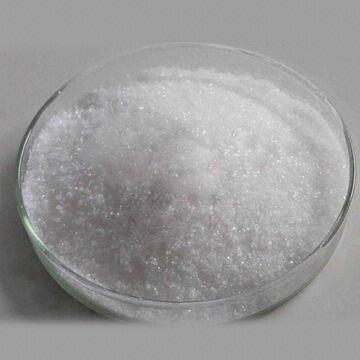| Description | Zinc bromide (chemical formula: ZnBr2) is an inorganic compound consisting of zinc and bromide. It is manufactured through the reaction between zinc oxide (alternatively, zinc metal) with hydrobromic acid, alternatively by the reaction between zinc metal and bromine. It is a kind of Lewis acid in organic chemistry. It can be used as the electrolyte in the zinc bromide battery. In oil and natural gas industry, its related solution can be used to displace drilling mud. Moreover, its solution can be used as a transparent shield against radiation. Finally, it can be used as a catalyst for the Stereospecific and regioselective reaction between silacyclopropanes with carbonyl compounds.

|
| References | https://en.wikipedia.org/wiki/Zinc_bromide
https://www.alfa.com/en/catalog/B22510/
|
| Chemical Properties | Zinc bromide is an odorless white crystalline solid or white hygroscopic powder. |
| Physical properties | White crystalline powder; sharp metallic taste; orthorhombic structure; refractive index 1.5452; density 4.20 g/cm3; very hygroscopic; melts at 394°C; vaporizes at 650°C; highly soluble in water 447g/100 mL at 20°C; aqueous solution acidic; very soluble in alcohol, ether, and acetone; soluble in alkali hydroxides and ammonia solution. |
| Uses | Zinc bromide is a white crystalline powder prepared by dissolving zinc carbonate in hydrobromic acid.
Zinc chloride (ZnCl2) is a white granular crystal made by the action of hydrochloric acid on zinc.
Zinc iodide (ZnI2) is a white powder made by dissolving zinc in ionic acid. All of the zinc halides are soluble in water, alcohol, and ether. They were all used as halides for the collodion emulsion processes. |
| Uses | Optimal catalyst for stereospecific and regioselective reaction of silacyclopropanes with carbonyl compounds.1 |
| Uses | Making silver bromide collodion emulsions for photography; in the shielding of viewing windows for nuclear reactions. |
| Preparation | Zinc bromide is prepared by mixing barium bromide and zinc sulfate solutions. The product barium sulfate is removed by filtration and the filtrate is evaporated to obtain crystals of zinc bromide: BaBr2 + ZnSO4 → ZnBr2 + BaSO4
Zinc bromide also may be prepared by the action of zinc with hydrobromic acid followed by crystallization. |
| General Description | A white crystalline noncombustible solid. The primary hazard is the threat to the environment. Immediate steps should be taken to limit its spread to the environment. Zinc bromide is used in medicine, in photography. |
| Air & Water Reactions | Hygroscopic. Water soluble |
| Reactivity Profile | Acidic inorganic salts, such as Zinc bromide, are generally soluble in water. The resulting solutions contain moderate concentrations of hydrogen ions and have pH's of less than 7.0. They react as acids to neutralize bases. These neutralizations generate heat, but less or far less than is generated by neutralization of inorganic acids, inorganic oxoacids, and carboxylic acid. They usually do not react as either oxidizing agents or reducing agents but such behavior is not impossible. Many of these compounds catalyze organic reactions. |
| Health Hazard | Inhalation of dust may irritate nose and throat. Ingestion can cause irritation or corrosion of the alimentary tract; if large amount is swallowed and not thrown up, drowsiness and other symptoms of bromide poisoning may occur. Contact with eyes or skin causes irritation. |
| Flammability and Explosibility | Nonflammable |
| Potential Exposure | Zinc bromide is used in photography,
rayon manufacturing and medicine |
| Shipping | UN3260 Corrosive solid, acidic, inorganic, n.o.s.,
Hazard class: 8; Labels: 8-Corrosive material, Technical
Name Required. UN3077 Environmentally hazardous substances,
solid, n.o.s., Hazard class: 9; Labels: 9-Miscellaneous
hazardous material, Technical Name Required. |
| Purification Methods | Heat ZnBr2 to 300o under vacuum (2x10-2 mm) for 1hour, then sublime it. [Wagenknecht & Juza Handbook of Preparative Inorganic Chemistry (Ed. Brauer) Academic Press Vol II p 1072 1965.] |
| Incompatibilities | Keep away from alkali metals.
Incompatible with oxidizers (chlorates, nitrates, peroxides,
permanganates, perchlorates, chlorine, bromine, fluorine,
etc.); contact may cause fires or explosions. Keep away
from alkaline materials, strong bases, strong acids, oxoacids,
epoxides, metallic sodium, or potassium. Store above
32 ℉/0℃. |



